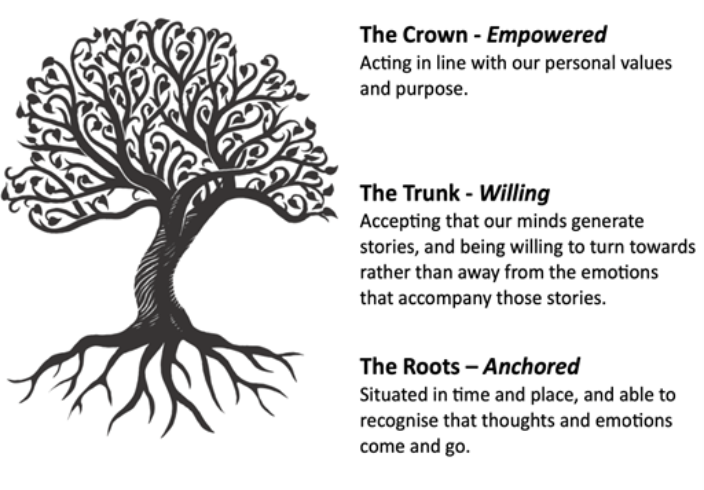The Wisdom of Trees: A Metaphor for Psychological Flexibility
Whether it’s the fruit they grow, the shelter they offer, or the materials they provide, we have a lot to thank trees for.

Considering that trees have been around for at least 350 million years longer than us, there’s much we can learn from them about thriving.
I first encountered the Tanzanian proverb "The wind does not break the tree that bends" while working on mental health projects in sub-Saharan Africa. This proverb, which conveys resilience, has stayed with me ever since. I realised that the anatomy of a tree serves as a powerful metaphor for psychological flexibility—our ability to stay present and adjust our behaviours to align with our values, even when faced with difficult emotions.
A Flexible Mind: Anchored, Willing, and Empowered (A.W.E.)
In my work as a clinical psychologist in high-pressure environments like elite sports and business, I emphasise the importance of developing psychological flexibility, or what I refer to as a ‘flexible mind.’ In my new book, The Tree That Bends: How a Flexible Mind Can Help You Thrive, which draws on cutting-edge psychological theory and research, I explain how the three elements of a flexible mind—being Anchored, Willing, and Empowered (A.W.E.)—correspond to different parts of a tree:
- The Roots - Anchored: Just as a tree is rooted in the ground, we need to be grounded in time and place, and able to recognise that thoughts and emotions come and go.
- The Trunk- Willing: Like a tree that bends with the wind, we must be open to experiencing difficult emotions without letting them dictate our actions.
- The Crown - Empowered: Just as a tree uses energy for growth and renewal, we need to feel empowered to act in line with our purpose and personal values

The Balance of Life: Get, Threat, and Reset Modes
But it’s not just the anatomy of a tree. The way it functions offers important lessons for thriving. A tree balances its energy across three modes:
- Get Mode: Using sunlight to fuel growth through photosynthesis during spring and summer.
- Threat Mode: Responding to damage or infestation.
- Reset Mode: Entering dormancy during autumn and winter for consolidation.
Similarly, to thrive, we also need to balance our energy and effort between our Get (striving for rewards), Threat (surviving dangers), and Reset (reviving through self-care) modes. Rather than being a specific mindset, a ‘flexible mind’ enables us to access a range of mindsets that are optimised to the different contexts we find ourselves in.
Misconceptions About Success and Burnout
As a clinical psychologist, I often encounter several misconceptions about achieving success and avoiding burnout:
- Success is Binary: Many people see success as either winning or losing. However, for me, this perspective is wide of the mark. I love the quote attributed to Nelson Mandela which states “I never lose, I either win or learn”. By adopting this attitude, we can appreciate that falling short isn’t failure, it’s feedback.
- Succeed at All Costs: The ‘No limits’ and ‘Do more to be more’ approach to achieving goals has led to many people sacrificing their well-being at the altar of supposed success. And the cost can be counted in the rising numbers of people experiencing burnout. Although ‘burnout’ is not classified as a mental health condition, it is a risk factor for developing a range of mental health difficulties including depression and anxiety disorders.
- Individual Responsibility for Burnout: While individuals can develop strategies to manage burnout, change must also occur at the organizational level. Organizations need to create environments that support well-being to prevent burnout.
Practical Strategies for Developing a Flexible Mind
There are a range of strategies that can be used to help develop the Anchored, Willing and Empowered aspects of a ‘flexible mind’. If you notice that you are engaged in mental time-travel to the past or to the future and you’re losing contact with the ‘here and now’, you can use your senses to get Anchored back into the present moment. In The Tree That Bends, I offer practical strategies for cultivating a ‘flexible mind’:
- Anchored – Notice what you can see, hear and feel: Use your senses to reconnect with the present moment. Notice what you can see, feel, and hear around you. Examples include, picking three objects and describing their shape and colour to yourself. Or, focusing on sounds and where they originate from. How loud are they? Are there any variations in the sound of that silence? Be curious.
- Willing: If you struggle with avoiding difficult emotions, try my P.O.P.L.A.R. method which will assist you to be more Willing to allow space for those emotions:
- Pick up on your emotional reaction.
- Observe the most prominent emotion – is it anger, fear, shame, guilt panic, or something else?
- Pinpoint your urges to react without acting on them. For example, depending on the situation, you might be tempted to quit, remove yourself from the situation, send a strongly worded email, placate the other people present etc. See if you can allow the urges to be there without reacting to them.
- Locate the emotion in your body– is it in your chest, abdomen, head, or somewhere else?
- Assign physical properties to the emotion. For example, if it had a colour, what would it be? If it had a weight, what would it be? If it had a texture, what would it have? And so on.
- Recognise that you can hold the emotion and still choose how to respond.
- Empowered: Imagine spending a ‘Day on Purpose,’ where you can choose to do things you’re passionate about. Consider the following questions:
- How would you choose to spend that day?
- What matters enough for you to spend it that way?
- What difference, if any, would you hope that doing that might make?
- How would you know that it had been a day well spent?
- How would you feel at the end of that day?
- If you could have more of those kinds of feelings in your life, would you want them?
Now take a moment to think how you might do more of that stuff - even 1% more - in your average week. What one concrete action could you take in the coming week to help you to do that?
Fostering Healthier Work Environments
Thriving is about both performing well and feeling well. Organizations must recognise that without well-being, performance declines. Research shows that three basic psychological needs are crucial for wellbeing:
- Autonomy: The need to exercise agency in our choices.
- Relatedness: The need for connection and care with others.
- Mastery: The need to develop skills and capabilities.
Reviews of the research evidence have consistently shown that failing to satisfy these psychological yearnings leads to lower well-being, fewer pleasant emotions, and more challenging emotions. To reduce burnout risk, organisational leaders must ensure that workplace culture, policies, and procedures foster autonomy, relatedness, and mastery. This includes consulting staff in safe and respectful ways, closing the consultation loop by addressing their concerns, and investing meaningfully in evidence-based mental health and wellbeing support. Additionally, employees' time away from work must be protected to allow for adequate rest, recuperation, and meaningful activities. These are fundamental building blocks for a thriving work environment.
Key Takeaway: Cultivate Your Purpose
One key takeaway from The Tree That Bends is the importance of being true to your sense of purpose. This is essential for thriving. Popular culture urges us to find our ‘why?’ – the causes that inspire and motivate us. But I believe purpose isn’t found; it’s formed. Clues to your purpose already exist in the activities that bring vitality to your life—helping others, supporting causes, learning new skills, or protecting the planet. Don’t wait to ‘find’ your purpose; instead, nurture what’s already there.
I advocate a ‘strong intention, light attachment’ approach to purpose. Be firm in your intentions, but flexible in the methods you use and how you choose to respond to setbacks. Recognise that when you commit to achieving a goal or ambition, you commit to experiencing challenges along the way. When it comes to your purpose, however, no defeat is ever final.

Professor Ross White
View ProfileMedia
Prof. Ross G. White
Professor of Clinical Psychology